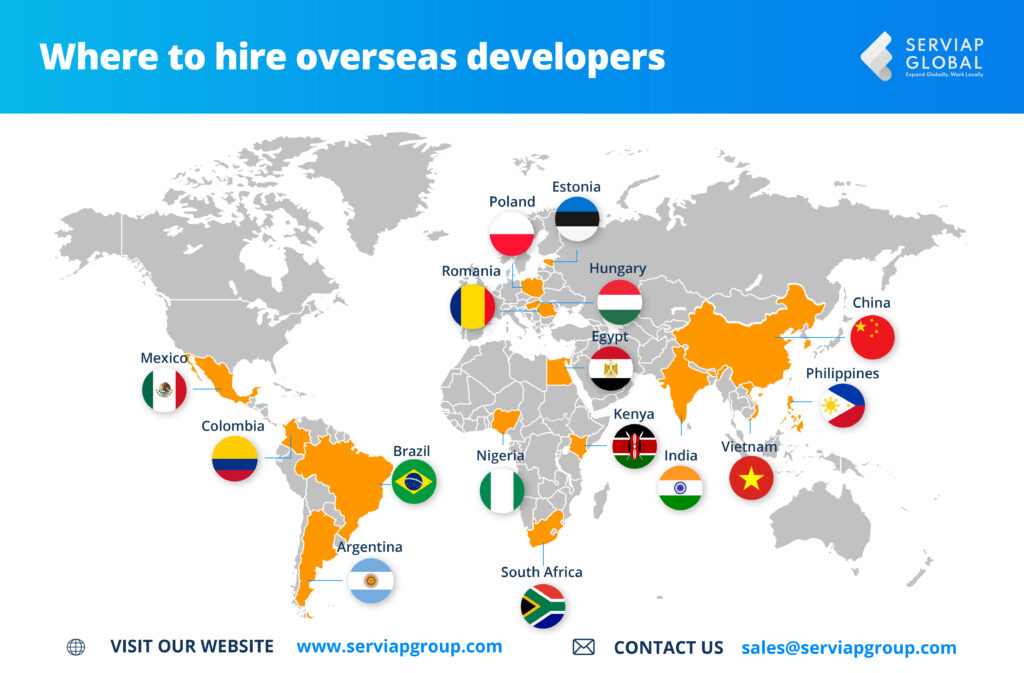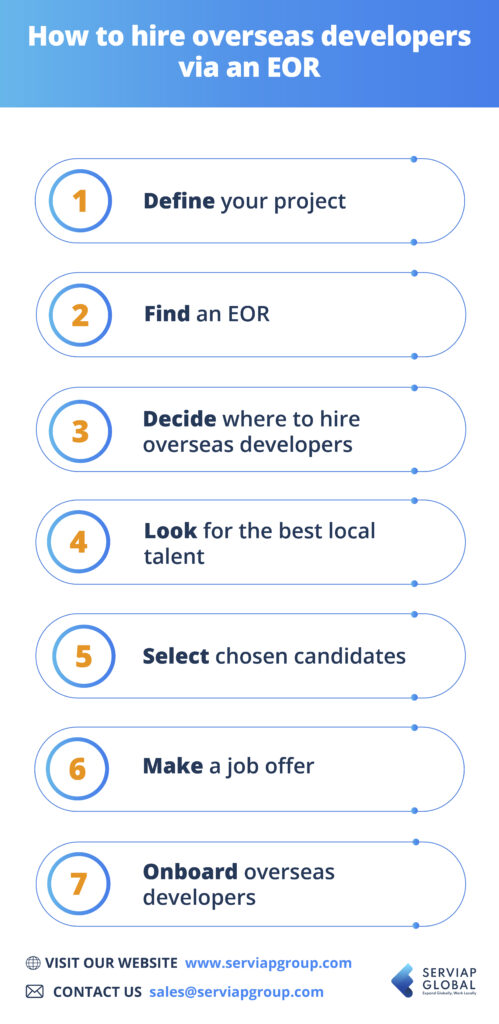Table of Contents
If you are looking to hire overseas developers, working with an employer of record (EOR) is a fast and convenient option that a growing number of companies are choosing.
An EOR hires international talent on behalf of its clients, handling the onboarding, payroll, and local compliance matters of those employees, who report directly to the client.
As such, hiring via an EOR means having overseas professionals in place in little more than the time it takes to find them, without needing to set up a legal entity or worry about getting to grips with unfamiliar local regulations. That makes it a popular choice among companies looking to establish a distributed workforce, or otherwise interested in global hiring.
Such an arrangement can be used for recruiting almost any type of role, and is particularly popular for companies looking to hire the likes of project managers, sales representatives, local executives, call center operatives, and IT workers, such as developers.
Generally, when you hire overseas developers, it is with the intention of recruiting highly skilled talent at competitive rates, charged with creating, designing, deploying, and supporting software. Basically, these programmers and engineers develop products that tell a computer what to do.
The software they will develop typically breaks down into four main types: system software, which provides essential functions such as operating systems; programming software, which provides programmers with tools to create code; application software, to help users perform tasks through apps; and embedded system software, which controls machinery.
SEE ALSO: Call center outsourcing: 5 great destinations to consider
When you hire overseas developers, they will generally operate remotely, making such roles particularly attractive to prospective candidates. When it comes to actually finding local talent in a chosen market, your EOR will have an established recruitment network and be able to help.
If you are flexible about where to hire overseas developers, an EOR will also be able to provide you advice on the best locations to choose, based on costs, time zones (should you need to be in regular contact with them), and the availability of talent.
If you are looking to hire overseas developers, or any other type of professional, contact us to find out more about how we can help.
Where to hire overseas developers
Depending on where you are based and what specialisms you need to hire overseas developers for, a wide range of countries offer good options, and your EOR will be able to help you decide.
Below, some great locations to hire overeseas developers around the world are highlighted.
Africa
A number of technology ecosystems in Africa are booming. In Egypt, for example, there is a government focus on technology as a future driver of growth, and the country is arguably North Africa’s startup leader.

In Nigeria, the government similarly encourages technological advancement and prioritizes IT education. In addition, English and French are the official languages, so many companies are looking to hire overseas developers in this territory.
South Africa, meanwhile, is the most industrialized, diversified, and technologically advanced economy in Africa, with a large pool of talented, innovative, and experienced software developers and a number of reknown startup ecosystems based in major cities.
Nairobi, the capital of Kenya, is a city that cares about fostering technological innovation among its inhabitants. That has helped it earn the nickname of the Silicon Savannah, and it is home to many programmers.
Asia
India is well-known for its massive IT industry, and technology companies play a big part in driving growth and creating jobs. Many foreign companies are partiocularly keen on hiring professionals in this country, given that English is widely spoken.
The Philippines has become a popular source of IT workers, offering skilled technology talent at competitive rates. These employees are especially valued due to the country’s high rate of English proficiency.
Robust technical ecosystems have emerged in Vietnam in the information technology, food technology, artificial intelligence, enterprise solutions, and fintech sectors. That has helped the Southeast Asian nation become a rising star as a source of tech talent.
China, the world’s largest economy, has a vast supply of engineers and programmers, so many companies can hire overseas developers in this country. With a wealth of innovative products, by 2030, it expects to become a techno-utopia with unique characteristics.
Europe
Companies that need to hire overseas developers to carry out IT projects often set their eyes on Poland, a country with a dynamic economy, a competitive workforce, and a large pool of qualified software engineers.
Estonia, where Skype was created, is one of the most digitally advanced societies in the world. Under its e-Estonia initiative, it fosters innovative education, virtual business, and digital citizenship, making it a hotbed of international developers.
SEE ALSO: Employer of record in Estonia: 6 important steps to hiring top talent
Meanwhile, Hungary is rapidly growing as a key destination for companies that want to hire overseas developers. It’s a full member of the EU, while offering a highly competitive tax regime. Education standards are high.
Finally, with its well-educated tech workforce, a history of academic computer research, and a strong outsourcing industry, Romania is becoming a central tech hub. Large corporations began arriving in the country, attracted by the low cost of living and low tax regime.
Latin America
Thanks to its startups, with notable development in online banking and financial technology (fintech), Brazil has emerged as a global tech leader. Many US and Canadian companies seek to hire overseas developers via an employer of record in Brazil.
Hiring employees in Mexico is popular as it has the largest startup ecosystem in the region, with over 350 success stories. Also, 25% of university students graduate in STEM subjects so it is possible to hire overseas developers easily.
Argentina has a world-class education system that focuses on technological skills. Higher education is free, and it tops the EF English Proficiency Index in Latin America. Because of this, it is emerging as an important outsourcing hub for software development.
Meanwhile, Colombia has an emerging economy that is shifting from a reliance on natural resources towards its young, skilled, and competitive labor force, which has given priority to technological development in recent years.

How to hire overseas developers via an EOR
If you prefer to avoiud the hassle of taking on direct hires internationally, there are two main ways to hire overseas developers via an EOR provider. The first involves the EOR hiring them on your behalf, acting as the official employer of those professionals in the eyes of authorities wherever they are based.
The second is to hire them as international independent contractors, working for a specific project or a determined period, which many EORs are also able to support.
An EOR will have a deep understanding of the market where they operate, meaning they will be adept at identifying the strongest candidates during recruitment processes, as well as knowing how to negotiate local regulations in order to onboard people in the shortest time possible.
An EOR will also be able to provide contracxts for the employees hired on your behalf, in full compliance with local laws. It will also guarantee that all statutory obligations, such as vacation time, bonuses, and maximum working hours are upheld.
When you hire overseas developers through an EOR, you will need to follow these steps:
1) Define your project
Before you hire overseas developers, you will need to properly define the IT project you want them to carry out, its specifications, the duration, the objectives you wish to achieve within your organization, and the budget you have for outsourcing professionals.
A clear idea of the software product you will need is essential since you are looking for developers with specific knowledge and skills. Thus, you will save time and money in hiring, speed up the development process, and become more competitive in an increasingly demanding market.
2) Find an EOR
You will need an EOR provider that best understands your needs and offers you a rate that fits your budget when looking to hire overseas developers. If you are planning to hire in multiple markets, or may want to move into other markets in the future, you will ideally work with a provider that can support you in multiple countries.
Moreover, if you are open to consiudering different markets, an EOR will be able to provide you with advice on the best options available to you.
3) Decide where to hire overseas developers
Several factors, such as salary ranges, language and availability of talent can lead you to decide between one geographic location or another when you hire overseas developers. Different countries play to different strengths, depending on what you need. If you already have a clear idea in your head of where you want to hire overseas developers, this step will come before choosing your EOR.
SEE ALSO: 4 major advantages of nearshoring worth considering
If you want to be able to easily communicate directly, hiring them in a closeby market that is on a similar time zone is likely to be your best option — something known as nearshoring. For companies in the United States and Canada, that will usually mean hiring them in Latin America, while for companies in Europe it will often mean hiring elsewhere in Europe or Africa.
4) Look for the best local talent

Once you have found an EOR and decided where to hire overseas developers, you will need to actually identify strong candidates for the the roles you have available.
Your EOR will use its recruitment network to find them, and will usually stage initial interviews with candidates, verifying they have the experience and knowledge to meets your needs, as well well as potentially testing for any soft skills you consider most beneficial.
5) Select chosen candidates
While your EOR will present you with a list of strong candidates, you will ultimately need to make the final decision on which are best suited to the role and to your company.
So, once the initial interviews have been carried out, you will likely want to carry out your own interviews before you hire overseas developers. This will give you an opportunity to ask more in-depth questions about their skills and knowledge, as well as get to know their personality a bit more.
6) Make a job offer
Once you have found the ideal candidate, your EOR will go through the process of making them a job offer, including details of their salary, benefits, and schedule.
If that offer is not accepted, based on your instructions, your EOR may then offer modified terms or make an offer to an alternative candidate. Once an offer has been accepted, your EOR will be able to begin onboarding them.
7) Onboard overseas developers
Now that you have completed the hiring process, it’s time to onboard your new overseas developers into your team. Share the project to be created, their activities, and the objectives you expect them to achieve, and introduce them to their colleagues.
Remember that to effectively manage any remote team, you’ll have to use digital tools to help you communicate well, review the progress of tasks and give feedback to your new software team members.
Serviap Global can help you to hire overseas developers
At Serviap Global, we assist clients with international PEO / EOR services in over 100 countries worldwide. We also offer global talent acquisition services to assist clients with finding candidates for direct hires.
We are a company with more than 12 years of experience that started operating in Mexico in 2010 and then expanded throughout Latin America and the rest of the world. We are committed to service excellence and a personalized approach wherever we operate.
Contact us to find out how we can help you hire overseas developers and learn about our other services.
If you were interested in this article on how and where to hire overseas developers, check out the rest of our coverage.




